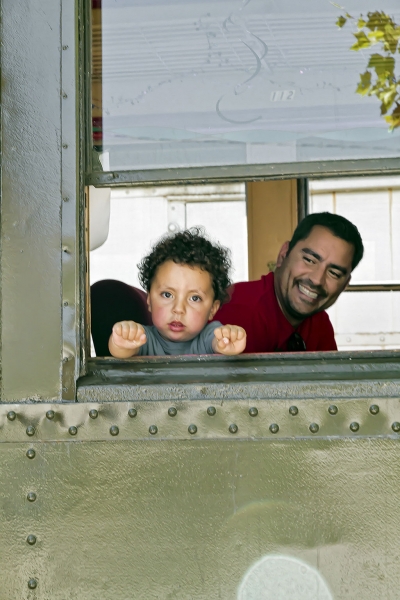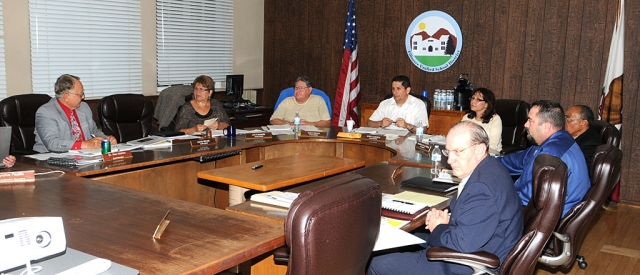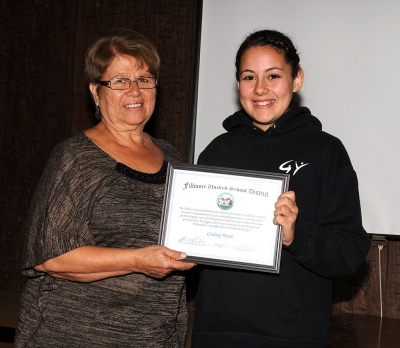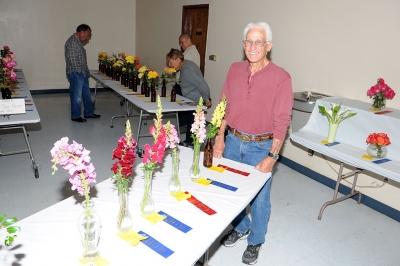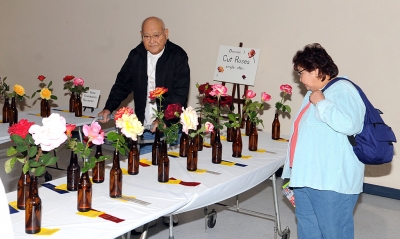|
By Bob Crum — Wednesday, April 24th, 2013
Story and photos by Bob Crum
If you could not find a parking space downtown last weekend, Thomas the Tank Engine is to blame! Whenever the bright blue engine with the forever smile rides the rails into town, Fillmore quickly gets populated by a throng of young'uns from all parts of Southern California. But can't blame the kids! Thomas the Tank Engine is soooo lovable... what with a huge beguiling grin and that oh-so unforgettable 'toot-toot'. That pervasive 'toot-toot' is not unlike the 'It's a Small World' tune playing in your head forever after a visit to Disneyland. There's no denying that Thomas the Tank Engine is the epitome of charm. Accordingly... an often heard refrain upon disembarking after a train ride with the infamous Thomas the Tank Engine is: 'No Johnny, we cannot take Thomas home with us'. And Johnny sobs... hoping the tactic with soften mom and dad's disposition. Doesn't work. Dad justifies the 'no' by explaining that their boat trailer is just too small for Thomas. But if you think the love affair is just between Thomas and kids... think again. Lots of grandparents are also seen swooning over Thomas. On the train... giggly grandparents wax nostalgic as Thomas nimbly propels them down the tracks. It's true... nostalgia is never out of style in Fillmore. If you missed toot-toot... er... Thomas the Tank Engine last weekend... fret not! The big, blue choo choo will be rambling up and down the tracks again this weekend. All aboard!!! Toot-toot! |
|
By Anonymous — Wednesday, April 24th, 2013
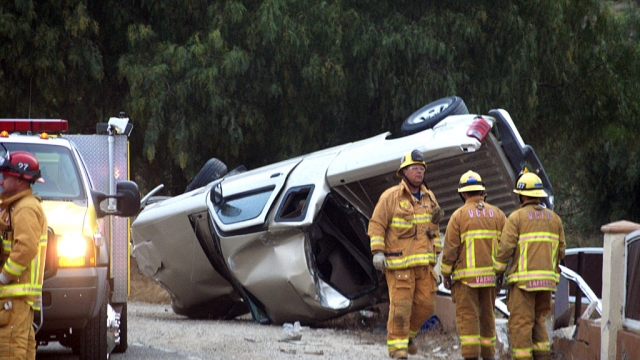 On the morning of April 22, about a mile south of the Bardsdale turn, a truck lays on it side. Photo courtesy Robert Sube. Enlarge Photo |
|
By Anonymous — Wednesday, April 24th, 2013
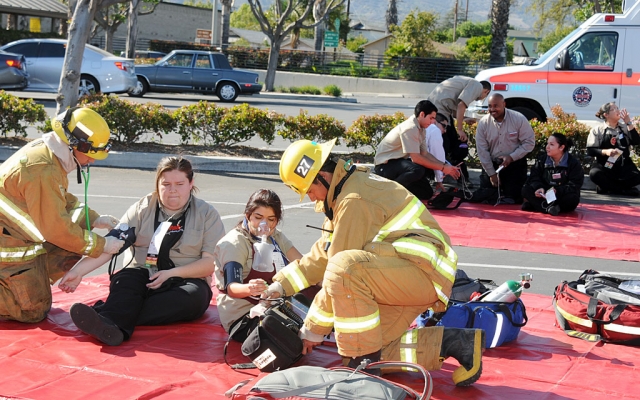 Fillmore Fire Department responded to the 600 block of Ventura St. (Vons Grocery Store) on 4/18/2013 for an unknown type odor. Upon arrival Fillmore Fire Chief determined there were several Vons employees displaying coughing and difficult breathing symptoms. There were a total of eight patients, five were transported by ambulance to nearby hospitals. Cause of the problem was linked to an oven fire that happened earlier in the day. No other injuries were reported. Vons reopened a few hours later. Enlarge Photo |
|
By Ventura County Sheriff Department — Wednesday, April 24th, 2013
A juvenile suspect was arrested in connection with an indecent exposure incident and later linked to two incidents of sexual battery. On April 18, 2013, a 15 year-old juvenile was arrested at his home a short time after a female reported being the victim of an indecent exposure. The female reported a young male approached her on a residential street and exposed his genitals to her. Patrol deputies responded and were able to locate the suspect who was subsequently arrested. The juvenile was lodged in juvenile hall. Fillmore Police Detectives linked the juvenile to two sexual batteries, which occurred in the same vicinity in mid March, 2013. Anyone having information related to these incidents, or has been the victim of similar crimes, is urged to contact the Fillmore Police Department. Nature of Incident: Suspect Arrested in Sexual Battery / Indecent Exposure Incidents |
|
By Anonymous — Thursday, April 18th, 2013
People with any info about these suspects call 1-800-CALL-FBI
|
|
By Anonymous — Thursday, April 18th, 2013
People with any info about these suspects call 1-800-CALL-FBI
|
|
By Jean McLeod — Wednesday, April 17th, 2013
The April 16,2013 Fillmore Unified School District (FUSD) Board Members heard both good and bad news. The good news is that the roofing of the gym has started and progress is on course for the opening of Rio Vista Elementary. Also, there was recognition of a student, Lindsey Bravo, who accomplished a goal and helped other students in doing so. The bad news is there are problems with bullying at Fillmore Middle School (FMS) that have parents very upset. Other items discussed were the purchase of a new math text for K-6 and new online courses. Parents of students who attend FMS will be happy to know that the leaky gym roof is in the process of being repaired and will be completed by May 31st. While this is being done the staff are working on a new design for the modular classroom roofs. Hopefully it will be an improvement on what is being replaced and hold up better. Board Member Virginia De La Piedra made a statement that people saying the roof was only twelve years old were mistaken and that the roof was over 20 years old. The Board agreed that when the original roof was being discussed they all wanted a pitched roof, but the cost to do so was too high and they were assured at the time by the builder that the flat style would not leak. This proved to be untrue but the company went bankrupt and little recourse remained. The cost to replace the roof is $454,393.44 with an added $5,600.00 for additional labor and materials necessary to replace deteriorated rain gutter system on the North and South lower roofs. The Board agreed to the added cost saying it would cost more to do it later as a separate project. Juan Toledo, father CONTINUED » |
 Pictured are Ray Llyod, Luanne Perez, Jack Stethem, Mark Ortega, Carmen Zermeno, Loni Larson, Katie Berber and Bene Amborsio. Enlarge Photo By Anonymous — Wednesday, April 17th, 2013
Vision 2020, Civic Pride Committee’s “Fiesta of Flowers”, Flower Show is over and all volunteers who have worked hard in preparations, set up & take down endeavors are enjoying the “glow” of pleasure that comes with appreciative comments from attendees and the satisfaction of having another great display of amazing, locally grown flowers and creative minds at work. There were many entering for the first time and many who came and spoke of wanting to enter next year. We have offered workshops each year, hoping to increase participation. Statistics showed that our “single stem cut rose” division had the largest number of entries at 123 roses, the second largest division, “other single stem cut flowers” at 37 and iris with 19, bouquets and miniatures with 15 each and youth entries at 14. The smallest divisions were the “dish garden” at 7 entries, “potted plants” at 5 and “arrangements” at 8 entries. There were 243 entries in all. Best of Show (Grand Prize) went to Mark Ortega with his variegated, orange flowered, Ambutilon potted plant. Division winners were: I Roses-Ray Lloyd (Peace), II Iris-Luanne Perez, III Other Single Stem Flower- Jack Stethem (New Zealand Tea Tree), IV Bouquets- Bene Ambrosio (white Watsonia “Brizza”), V Arrangements- Carolyn Lasky (Green Goddess Calla Lillies), VI Miniature Arrangements & Bouquets- Loni Larson, VII Potted Plant- Mark Ortega (Varigated Orange Ambutilon), VIII Dish Garden- Carmen Zermeno (succulents), IX Youth Arrangements- Katie Berber (roses in sombrero), X Youth Composition- Arielle Estrada ( collage with prose). Many merchants & individuals gave their support by donating door raffle prizes which helps us raise funds for future shows and projects in the community. We owe them a big “thank you” and ask that people check out their stores, shop locally and express your appreciation for their involvement in the Fillmore community efforts. Merchants donating prizes: Chivas Skin Care in Bardsdale, Cookie Lee Jewelry (Ari Larson), Diamond Realty Team (Robledo family), Elkin’s Golf Course, Fox & Hound Treasures & Antiques, Nanette Keller Clothing, Otto & Sons Nursery, Patterson’s Hardware, Vallarta Restaurant, Vic’s Tires. Merchants from Ventura that made donations were Green Thumb Nursery and Trader Joe’s. Local artists, Judy Dressler and Wana Klasen donated lovely paintings and King & King Ranch donated beautiful fruit baskets. Carolyn Lasky once again donated her special orchids. There will be a BBQ at the King Ranch for all who volunteered in helping at the show to review the show and gain fresh perspective for next year. If you have ideas that could help us work “smarter” in promoting, providing workshops, fundraising or in any other capacity, please get your comments to Linda Nunes at 524-3021 or to Joanne King at 524-4904. We are actively seeking people who might be interested in involvement as leaders or helpers. It is a great way to meet people and make a difference in your community! |
|
By Jean McLeod — Wednesday, April 17th, 2013
The special joint meeting of the Fillmore City Council and Planning Commission held on Wednesday, April 3, 2013 began with a swearing in of Mark Greenwall and Diane McCall as new Commissioners. But the majority of the meeting was spent listening to a presentation by Rincon Consultants regarding the Chevron project known as Fillmore Works. This was only a discussion and dialog session, with no decisions made, on ways to move forward with the project that will take a number of years to complete. The project requires zoning changes and annexing 52 acres of land outside the City limits. Currently there are 13 parcels that the developers would like changed to 23. The new parcels would include; eight for commercial highway use, nine for manufacturing/industrial, five for public facilities and one for open space. Last February Rincon Consultants, a company very familiar with Fillmore, was awarded the contract to represent Fillmore and oversee the project. Rincon has worked on a number of projects in town that include the Fillmore Business Park Master Plan, North Fillmore Specific Plan, General Plan, Fillmore Townhomes, Santa Clara River Levee Project, Fillmore Waste Water Treatment Plant Construction Monitoring, and Fillmore Contract Planning Services. For this project the company is under contract by the City of Fillmore but funded by Texaco Downstream Properties (a subsidiary of Chevron) at a cost not to exceed $190,573, which includes a 20% contingency fee. A portion of the site is CONTINUED » |
|
By Anonymous — Wednesday, April 17th, 2013
 Maria Villalobos - Maria is the daughter of Rodolfo Villalobos and Maria Orozco. She is 18 years old and a senior at Fillmore High School. Enlarge Photo  Hailee Smith - Hailee is the daughter of Jerry and Shanna Steelsmith and Alan Smith. She is 17 years old and a senior at Fillmore High School. Enlarge Photo  Natalie Johnston - Natalie is the daughter of Doug and Christine Johnston. She is 14 years old in the 8th grade at Sacred Heart. Enlarge Photo  Laura Garnica - Laura is the daughter of John and Beverly Garnica. She is 17 years old and a senior at Fillmore High School. Enlarge Photo  Savannah Bullard - Savannah is the daughter of David and Cynthia Bullard and Randy and Mary-Allyn Garcia. She is 17 years old and a senior at Fillmore High School. Enlarge Photo  Hannah Wishart - Hannah is the daughter of Mike and Tressa Saviers and George and Sui Wishart. She is 15 years old and a freshman at Fillmore High School. Enlarge Photo  Caitlin McCall - Caitlin is the daughter of Kerry and Diane McCall. She is 16 years old and a junior at Fillmore High School. Enlarge Photo  Sarah Scott - Sarah is the daughter of Thomas and Nikole Scott. She is 15 years old and a sophomore at Fillmore High School. Enlarge Photo  Destiney Saint Pierre - Destiney is the daughter of Marc Saint Pierre and Harold and Ramona Moore. She is 13 years old and in the 8th grade at Fillmore Middle School. Enlarge Photo  Danielle Ramirez - Danielle is the daughter of Raul and Diana Ramirez. She is 16 years old and a sophomore at Fillmore High School. Enlarge Photo  Erika Mendez - Erika is the daughter of Anthony Mendez and Joann Aparicio. She is 15 years old and a sophomore at Fillmore High School. Enlarge Photo  Connie Quintana - Connie is the daughter of Danielle Quintana. She is 14 years old and in the 8th grade at Fillmore Middle School. Enlarge Photo  Gabriella Munoz - Gabriella is the daughter of Michael and Lisa Munoz. She is 14 years old and attends homeschool. Enlarge Photo  Isis Garibay - Isis is the daughter of David Munoz and Sylvia Garibay. She is 16 years old and a sophomore at Fillmore High School. Enlarge Photo  Lindsay Bravo - Lindsay is the daughter of Jose and Sara Bravo. She is 13 years old and in the 8th grade at Fillmore Middle School. Enlarge Photo  Desirae Perez - Desirae is the daughter of Todd and Chrissy Schieferle and Randy Perez. She is 17 years old and a senior at Fillmore High School. Enlarge Photo  Breanna Berrington - Breanna is the daughter of Jeff and Denise Berrington. She is 15 years old and a sophomore at Fillmore High School. Enlarge Photo |











